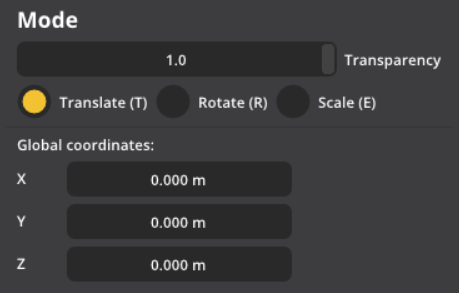Calibration
Overview
When sensors connect to the software, the sensors become part of the SENSR world. To combine multiple sensors, SENSR needs to understand where each sensor is so that it can transform and merge the information into a single coordinate system. This process is called the Calibration Process.
This chapter will walk you step-by-step through the calibration process using the sample data that is available as part of the SENSR system. The same principles can be used to calibrate your LiDARs.
Pre-requisite
This tutorial is based on SENSR's sample data, to follow along with this tutorial, you will need to download the sample data:
- Open a terminal window (CTRL-ALT-T)
- Navigate to the folder
/opt/seoulrobotics/utils - Type:
./download_sample.sh
The script will download the sample data that will be used
Project setup
For this tutorial we will create a brand new project, run our pre-packaged sample data and calibrate the sensors.
Create the Tutorial Project
- Either in the first start screen or through the File>New Project menu, create a new project. We’ll call it ‘tutorial’.
- Leave the directory as default to ensure the rest of the tutorial matches your configuration
- Enter ‘tutorial’ as the Project name.
- Click Done
Set up Sample Replay
Click on Algo Node Settings gear icon.
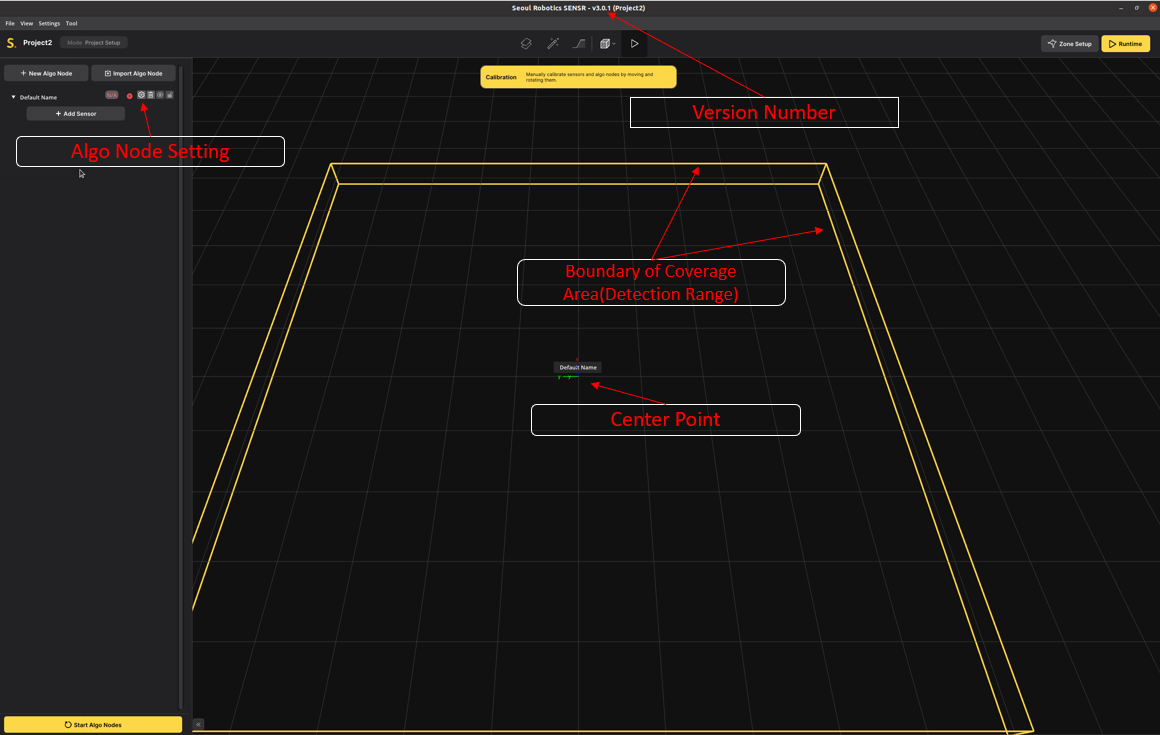
- Fill in the full sample data path. If everything is installed in the default locations, the path will be
/root/seoulrobotics/samples/sample_data.bag - Click
Confirm
- Fill in the full sample data path. If everything is installed in the default locations, the path will be
Set up Sensors
Click '+ Add Sensor' to add sensors If you cannot see '+ Add Sensor', click a toggle button next to the Algo Node name Default Name as default.
Click 'Lidar. Ros Message'. You will see Lidar Driver Configuration(ROS Message) window.
Fill in the Topic Name field.
How to Find Topic Name
A ROS bag can contain a wide variety of information. SENSR only requires the LiDAR point cloud data to function. To find out what data a ROSbag contains, you can query the bag file for its contents.
Open a new terminal (CTRL-ALT-T)
Navigate to the location of the bag file.
Type:
cd /opt/seoulrobotics/samplesType:
rosbag info sample_data.bagIf you get the error message: command ‘rosbag’ not found, type the following command before trying again:
source /opt/ros/noetic/setup.bash
You should see the following:
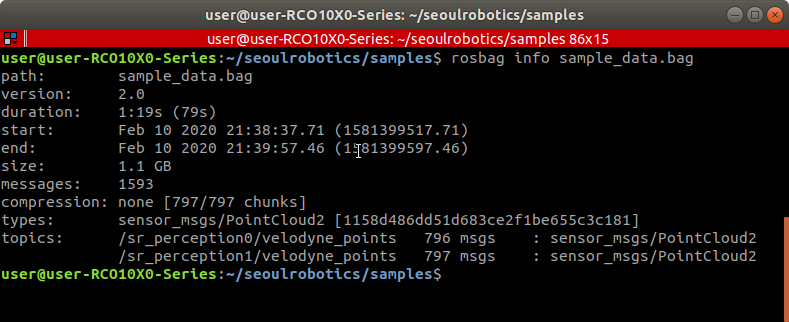
Any topic of type PointCloud2 can be used by SENSR
Click the + icon below the Sub Node
Identify the message type: in front of sensor_msgs/PointCloud2
- Give the sensor a unique name. For example ‘Sensor 1’
- Copy the *topic name* from the rosbag info into the Topic Name field.In this example: /sr_perception0/velodyne_points
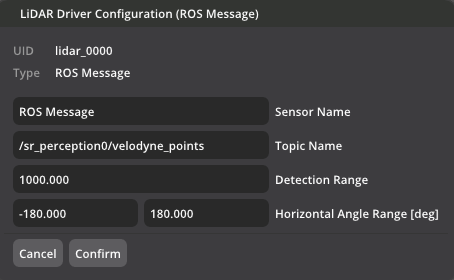
Click Confirm
Repeat this for all PointCloud2 topics in the bag file. For this sample_data.bag, you have to add one more sensor(topic).
You should have two sensors with unique names and topics associated with them. Make sure the second sensor has the topic name: /sr_perception1/velodyne_points
Click Start Algo Nodes to start the calibration process.
If everything went well, you should see the following on the screen.
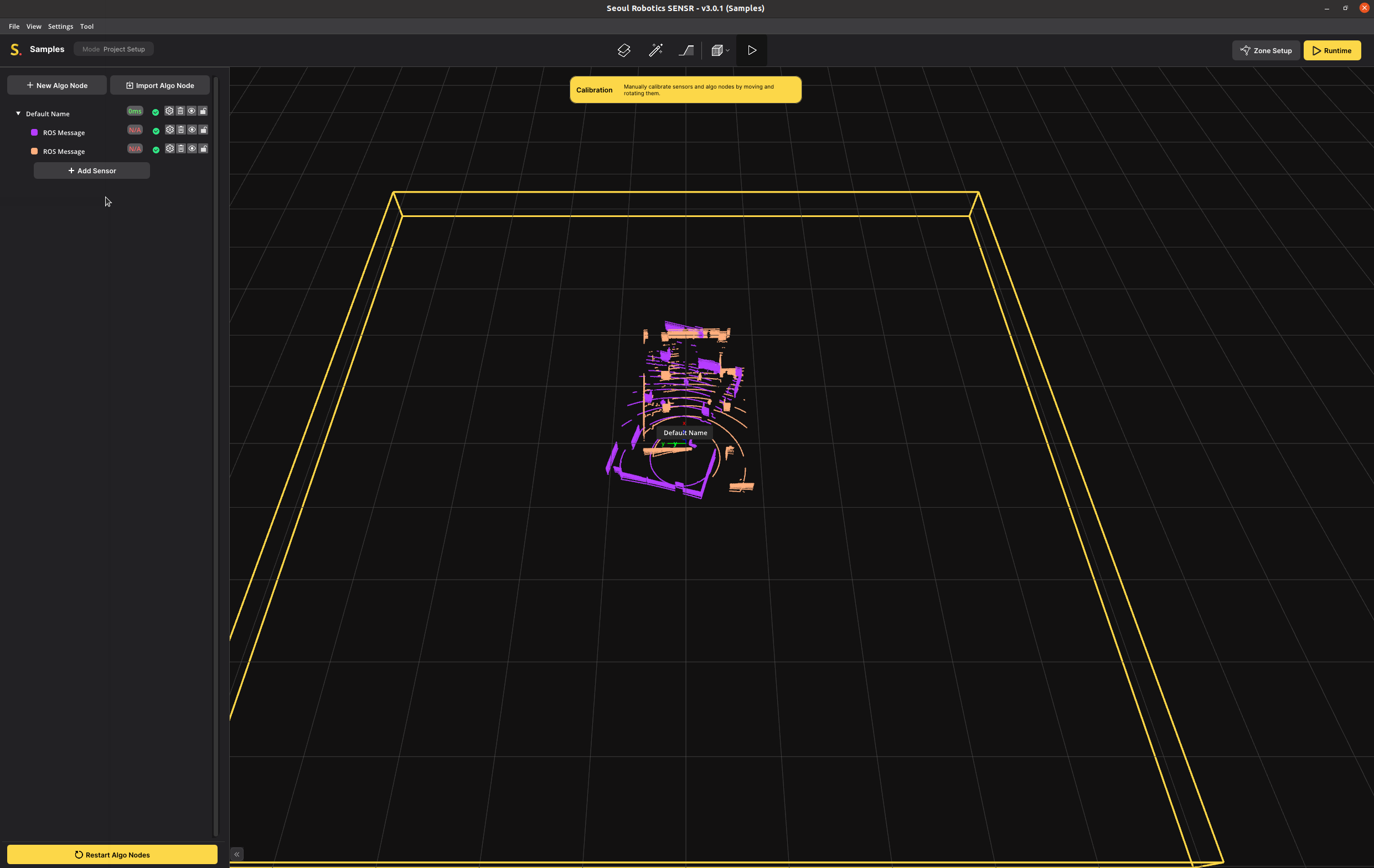
The green check marks in front of each item indicate that the Algo Node and Sensors are running and processing data correctly. Each sensor will generate a point cloud in its own color. As you can see the point clouds are displayed and both sensors are put in the default location.
Each node in the list has some buttons next to it. The functionality of each button is as follows:
- (Gear icon) Open up the settings window for the node.
- (Trash icon) Delete the node from your project.
- (Eye icon) Toggle the visibility of the node. If visibility is disabled the node cannot be interacted with
- (Lock icon) Lock the node in place and make it non-interactable. Locking an algo node also automatically locks the child sensor nodes of that algo node.
The scenario of the replay is three people walking around a room that also has a number of static pillars in it. Two sensors are placed at opposite sides of the room near the ceiling.
In the 3D viewport, you can use the mouse to move the camera position and angle relative to the 3D world.
- To move, hold the middle mouse button and move the mouse. The WASD keys can also be used to move.
- To rotate, hold the right mouse button and move the mouse around.
- To select, click the left mouse button when hovered over a point cloud.
You can also select specific sensors by clicking on their name in the list.
Calibration
Coordinate Systems
SENSR uses a right-handed coordinate system. The ground plane aligns along the X-Y plane and Z being altitude.
There are six values that have to be solved during the calibration phase. First is the location (X, Y and Z) and second is the rotation (Pitch, Roll, Yaw).
For the most common type of LiDAR, a rotating lidar, the lidar will rotate around the Z axis. The connector on the LiDAR is, in most cases, opposite to the zero angle, which is the rotation angle that is considered the start of a new rotation in the sensor. In the image this zero aligns along the X axis.
For this tutorial, and for calibration in general the following is defined:
- Rotation around Z = Yaw
- Rotation around X = Roll
- Rotation around Y = Pitch
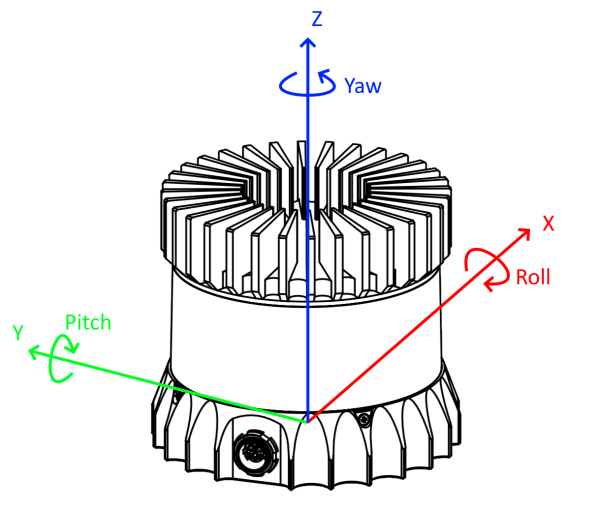
Start the Calibration Process
The two main goals to achieve during the calibration process are:
- Align the ground plane of the sensor to the ground plane of the SENSR software.
- Align each sensor relative to each other sensor.
It is important to know that, by default, nothing below the ground plane is being tracked, so correct ground alignment is critical to achieve good tracking performance and full coverage.
Calibration can be done many different ways. This tutorial describes one of the methods that can be applied to small and large installations alike. In this tutorial we are working with only two sensors, but in full deployments it could be 20 or more. At the start of a new calibration, SENSR places all sensors at the zero location (0,0,0). This can be confusing to work with, so it is recommended to start with a clean slate and calibrate sensors one at a time.
- Go to each sensor in the list and click on the eye icon. This will make each sensor invisible.
- Now make only Sensor 1 visible.
- Select Sensor 1 in the list by clicking on the name.
Now only Sensor 1 should be visible and selected. You can tell whether a sensor is actively selected by the point cloud belonging to that sensor turning white. As mentioned before, we need to resolve six values (X, Y, Z, Pitch, Roll, Yaw). For the very first sensor, it is best to start with ground alignment, this will solve three values all at once (Z, Pitch and Roll).
Before we do this:
- Go to the 3D viewport, hold the right mouse button and rotate the view until the camera is level to the ground.
This is when you cannot rotate any further and the yellow rectangle turns into a line. You are now in side-view. The yellow line indicates the ground level of the SENSR world. Below this level nothing will be tracked.
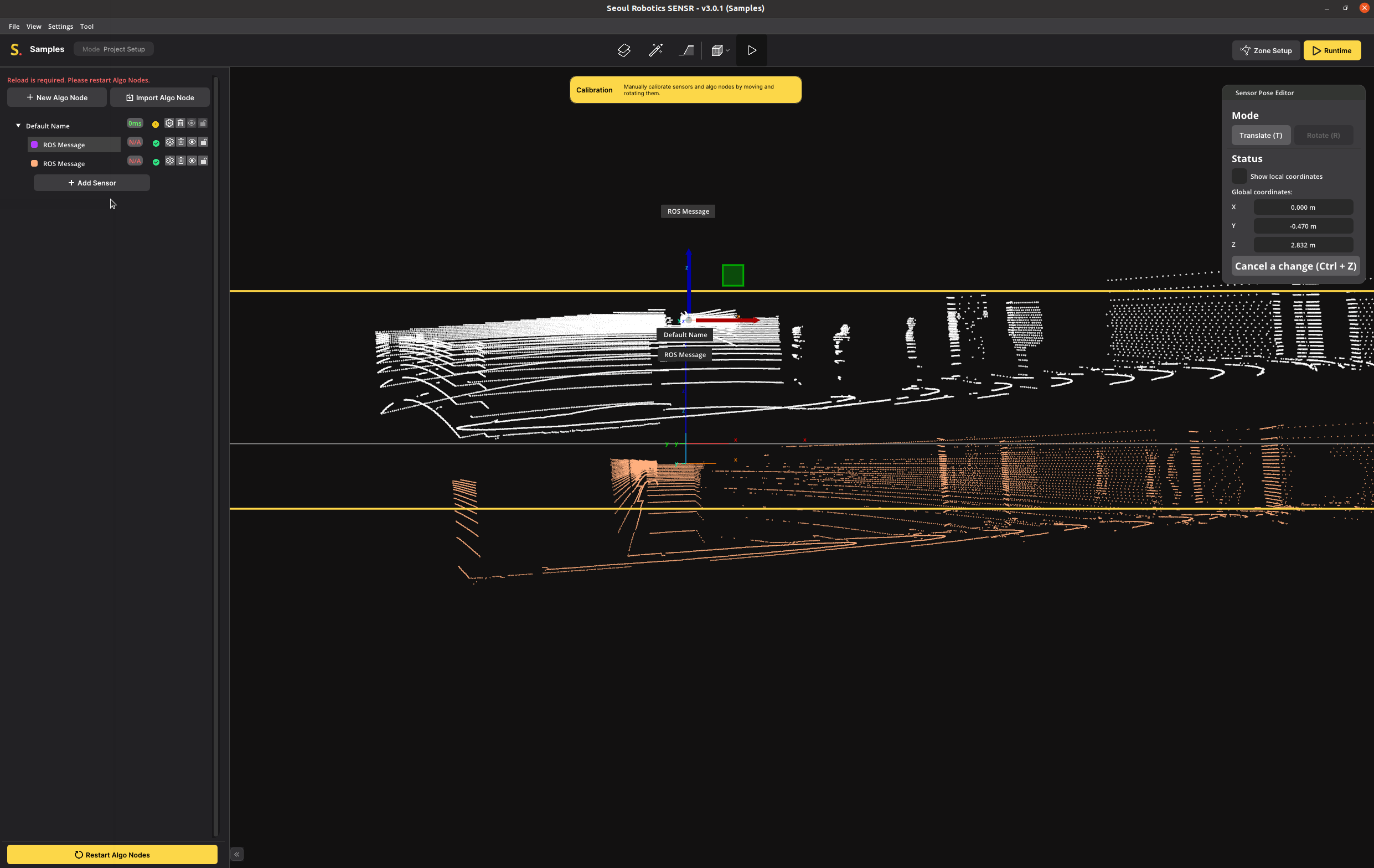
You can now clearly see that the majority of the point cloud is below ground level. This is because the Z of a new sensor is set to zero, so SENSR assumes that the lidar is on the ground.
Ground Alignment
Our first goal is to raise the Z to the actual installed height of the sensor and the ground level. The Ground Alignment tool allows to perfectly align the LiDAR's ground with the referential. It can be found in the Tool menu or by selecting a PointCloud and pressing the F4 key.
- Select the Ground Alignment icon on the Header or in the Menu bar Tool > Ground Alignment
- (Step 1) Select any point of your sensor to start the ground alignment for that sensor
- Click "Next"
- Rotate the point cloud to an angle where you have a good view of the ground
- (Step 2) Select three points that:
- You know are on ground level
- Are spread far apart
- And ideally form a wide triangle
- (Step 3) Compare the alignment result before and after, and Click "Apply".
- If the point cloud is upside down, click
Flipping Groundbutton to flip.
- If the point cloud is upside down, click
In this image the three yellow, green, red markers indicate the three selected points.
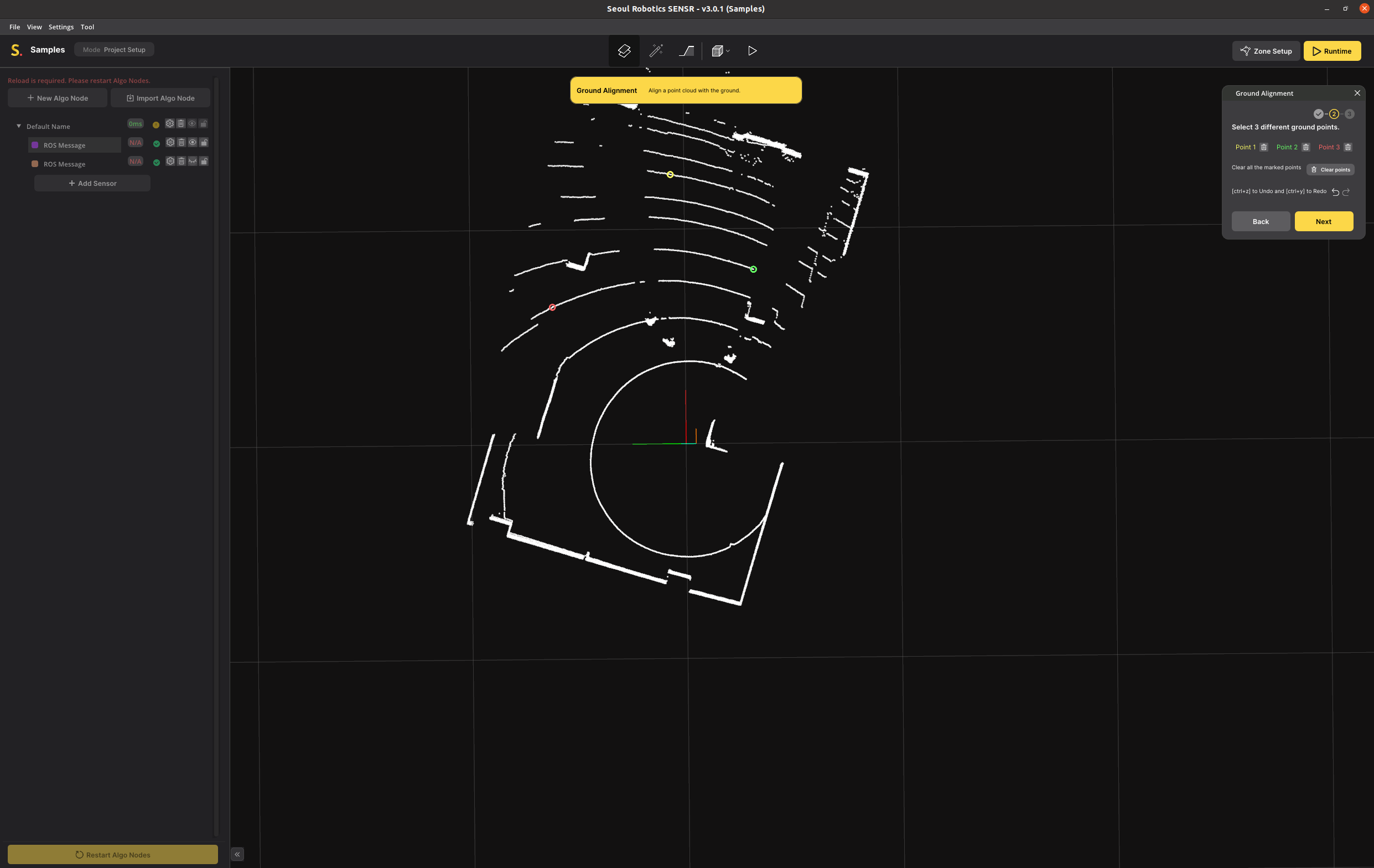 In this image the three colored markers indicate the three selected points.
In this image the three colored markers indicate the three selected points.
- (Step 3) Compare the alignment result before and after, and apply.
- Note: If the point cloud is upside down, click
Flip Groundbutton to flip.
- Note: If the point cloud is upside down, click
- Click on Launch the ground alignment
The point cloud's 3 points selected earlier are now aligned with the ground plane. You can verify the the proper alignment by selecting View > Side view and make sure the points are above ground as illustrated below.
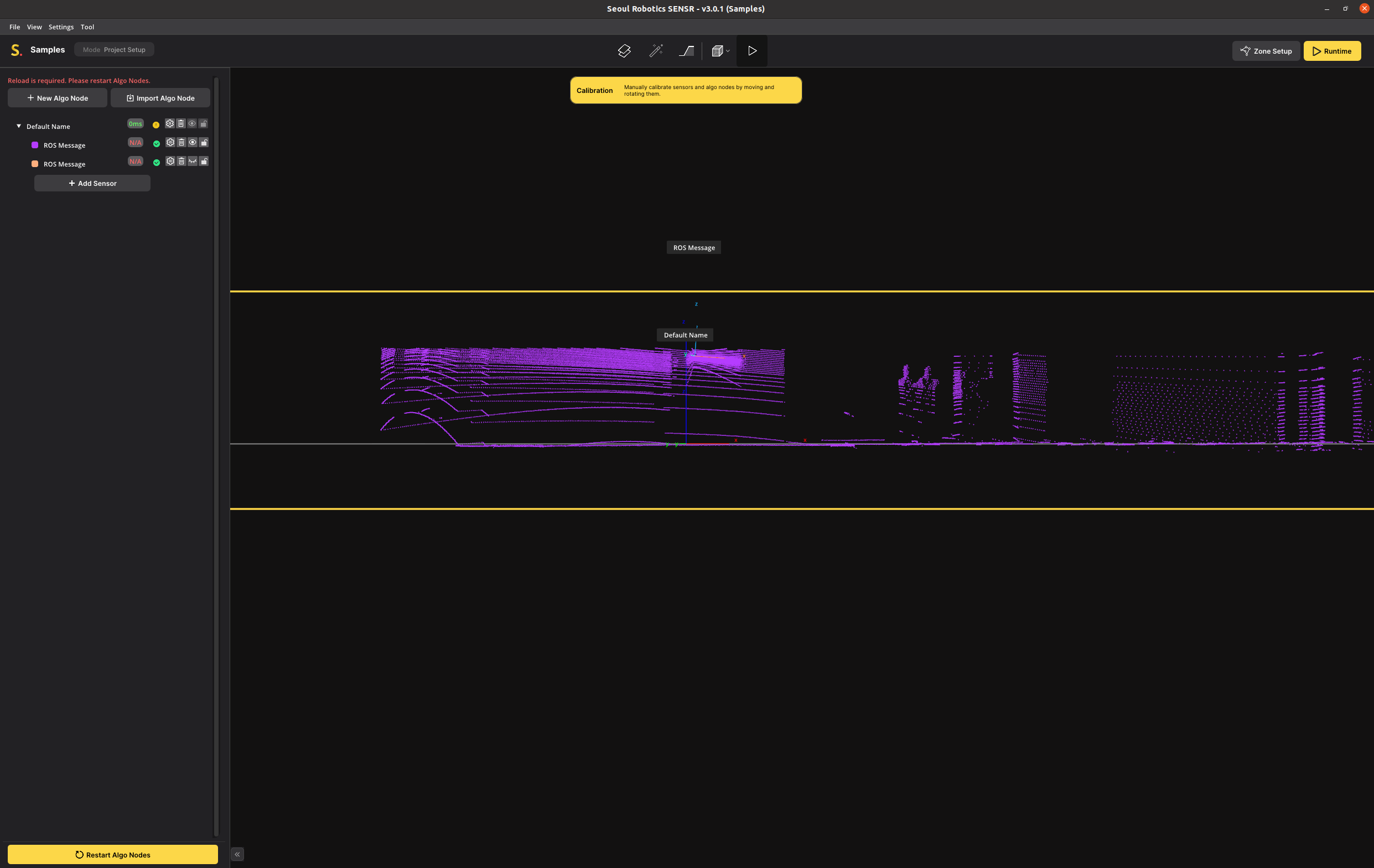
Repeat these steps for all your sensors to align everything with the ground plane as illustrated below:
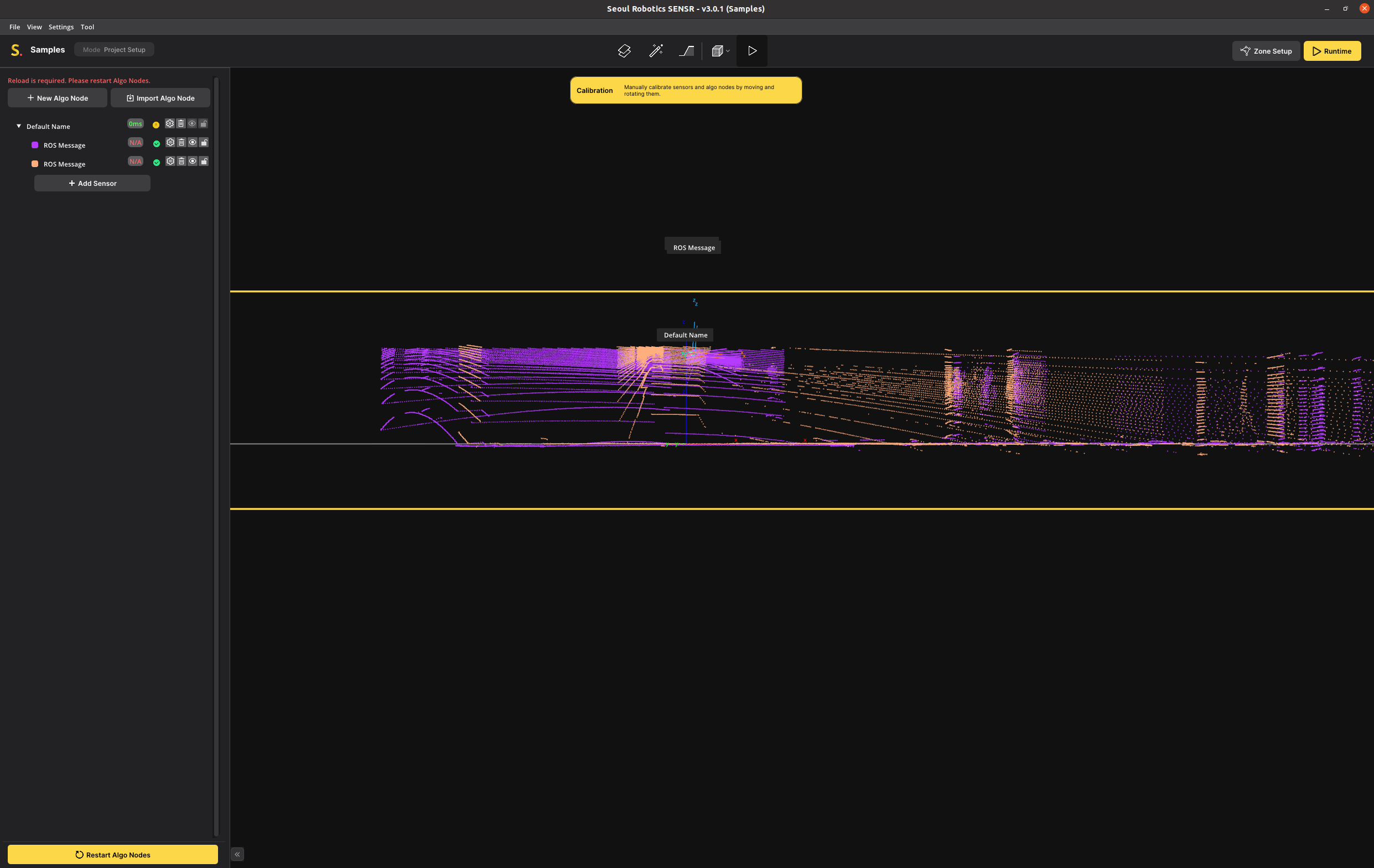
Moving and Rotating Sensors
Now the values Z, Pitch and Roll have been solved for both sensors. That leaves X, Y and Yaw.
To solve these, for indoor scenarios it is recommended to switch from Perspective to Top-view (Orthogonal) mode. This switches the system to a 2D top-down view and will remove the effect of perspective from the point cloud data and make it much easier to match up walls and corners.
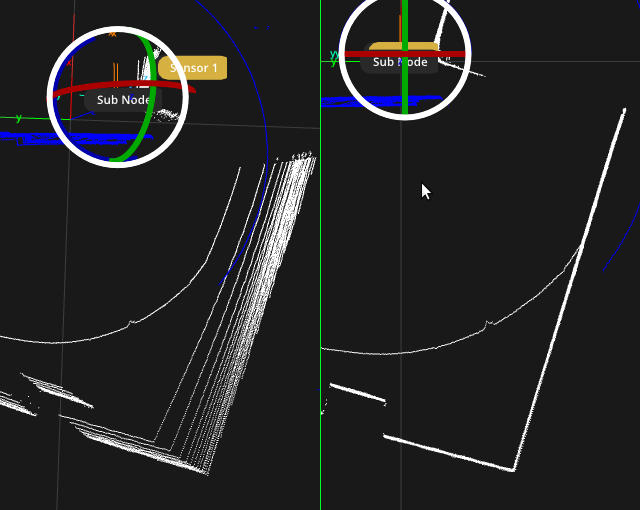
Just like the ground alignment, it is recommended to start with the first sensor and get it aligned properly. To do this:
- Make Sensor 2 invisible
- Select Sensor 1
You will see a Mode box pop-up on the screen. This box allows you to move the sensor and rotate it. We are going to fix Yaw first, so select the Rotate option or use the ‘R’ keyboard shortcut

There are a couple of ways to rotate.
- You can use the 3D widget on the left and drag it.
- You can hold the mouse on the Yaw field and drag it left to right. If you hold Shift while dragging, it will rotate faster.
- You can double-click or CTRL-click on the Yaw field to enter a value manually.
- Rotate Sensor 1 so the walls line up with the grid. The Yaw value should be around the 16.5 value for this tutorial.
- Sensor 1 is in place. To prevent any accidental movement of Sensor 1 you can click the Lock icon next to the sensor to lock it in place.
- Now make Sensor 2 visible.
It looks like Sensor 2 is already rotated correctly, but remember that Sensor 2 is at the opposite side of the room. This means that it actually has to rotate 180 degrees to align correctly to Sensor 1.
This is why it is important to, when you have a large coverage area with many sensors, have a floorplan ready as a reference with the rough installation locations of each sensor, so you have an idea of where each sensor should be relative to the others.
- Take Sensor 2 and rotate it by 180 degrees. In this case it is fastest to double-click the Yaw field and enter the value 180.
The final step is to move Sensor 2 so all the walls and pillars match Sensor 1. To do this:
- Switch to the Translate mode or press the ‘T’ keyboard shortcut.
- Move Sensor 2 so it matches Sensor 1
You have three options to move the sensor:
- Drag the blue rectangle in the 3D widget to move the sensor along the ground without affecting the Z value
- Hold and drag the mouse in the X and Y value boxes. Hold shift to move faster.
- Double-click or CTRL-click in X and Y to enter a manual value.
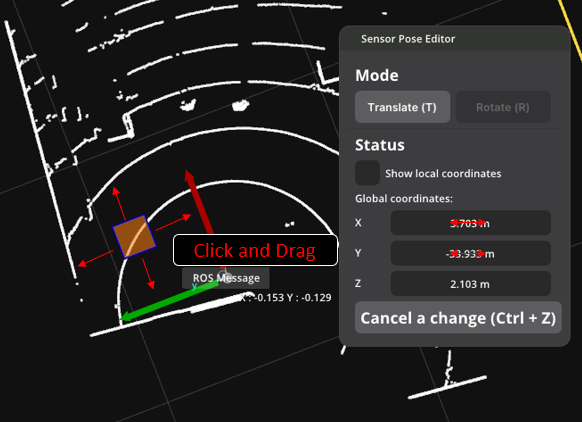
In this tutorial the X and Y value of Sensor 2 should be 13.6 and 2.0 respectively.
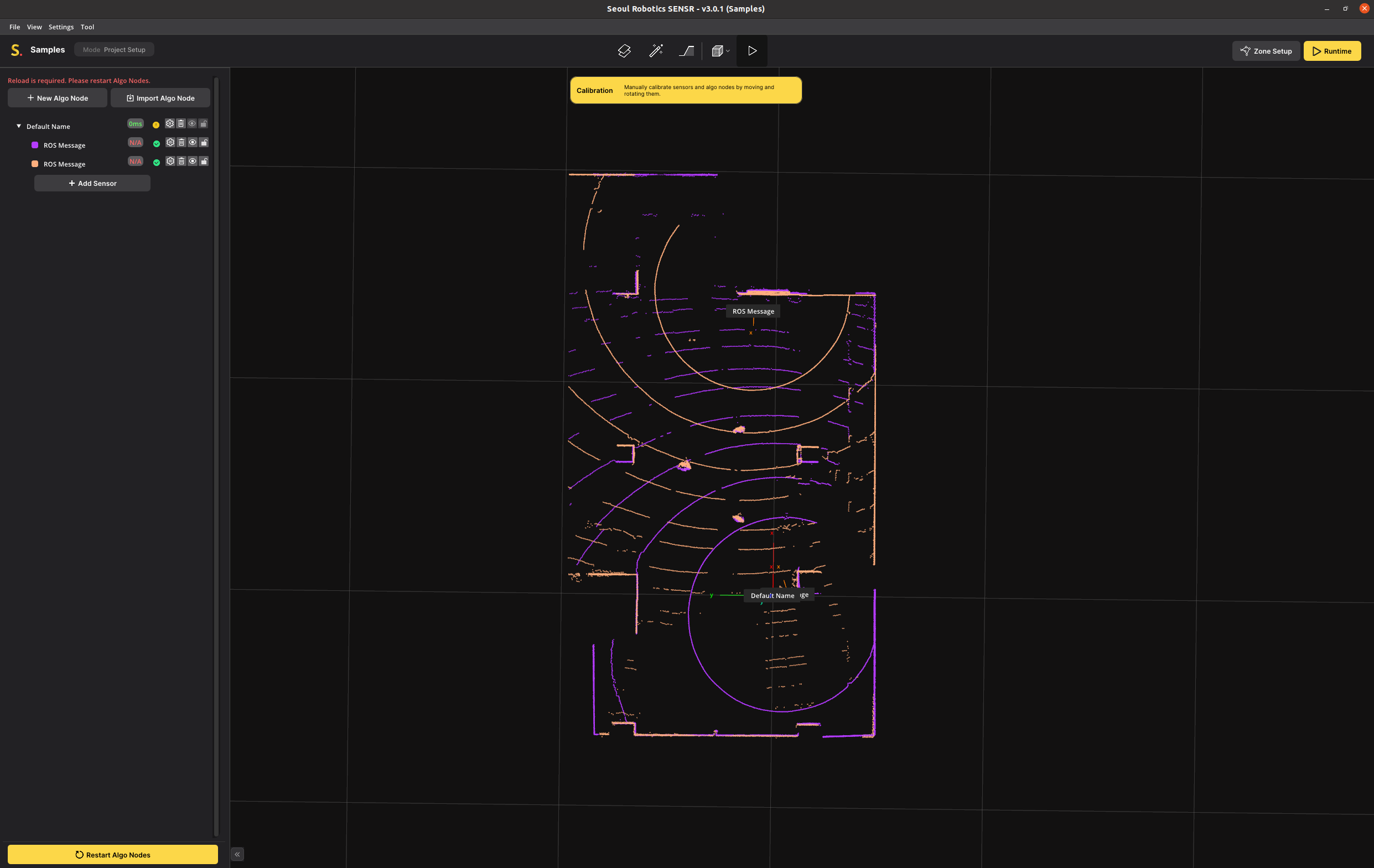
The final step is tweaking the location and the rotation so all walls and corners match up as close as possible. In general, for rooms like this, it is best to get the Yaw dialed in perfectly and then move the unit to the correct location. Long straight walls can be used to tweak yaw and hard corners are best to use for the final location.
In the image below, Sensor 1 is shown in purple and Sensor 2 in orange. Once get a perfect overlap, you can lock down the calibration of these two sensors.
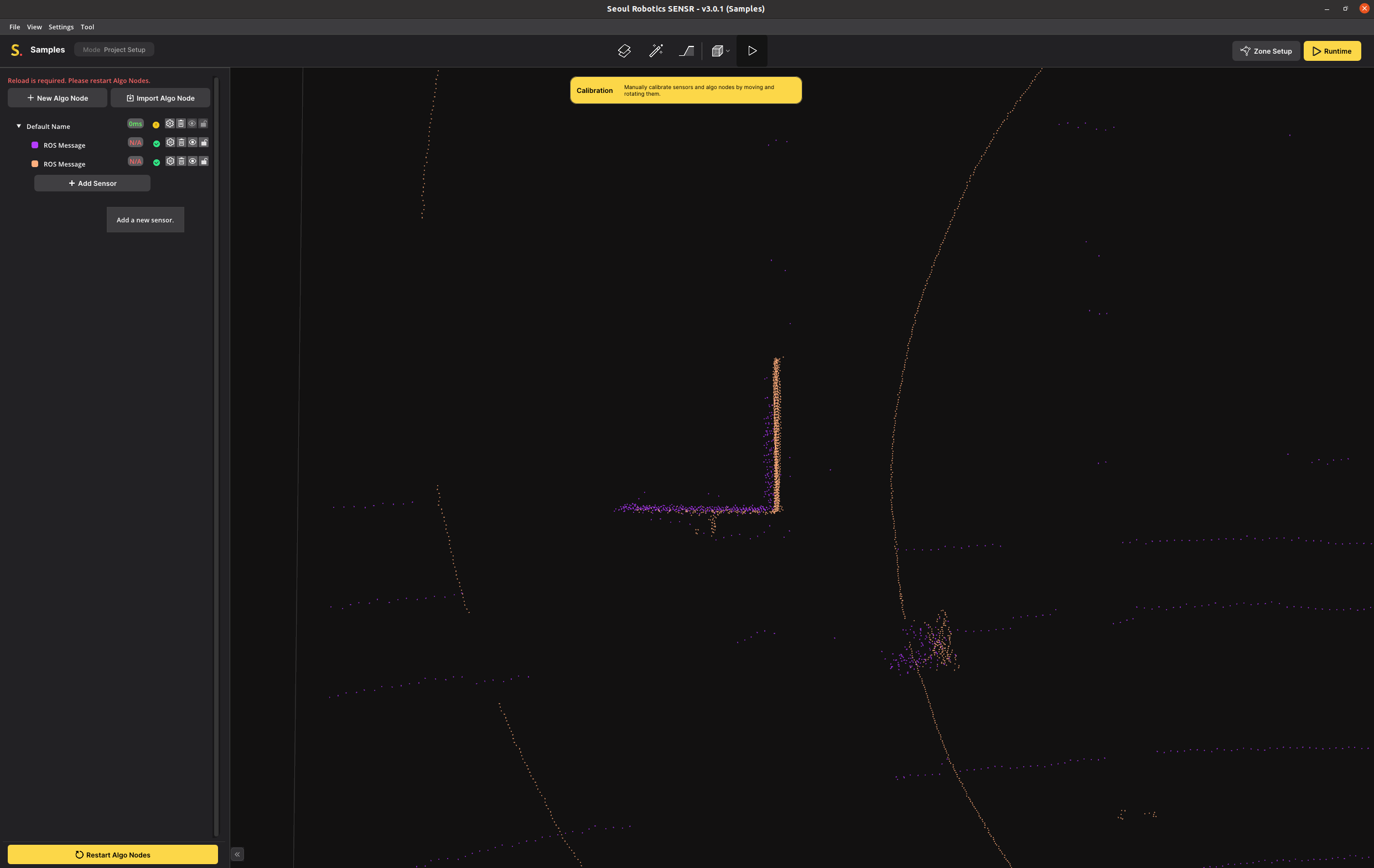
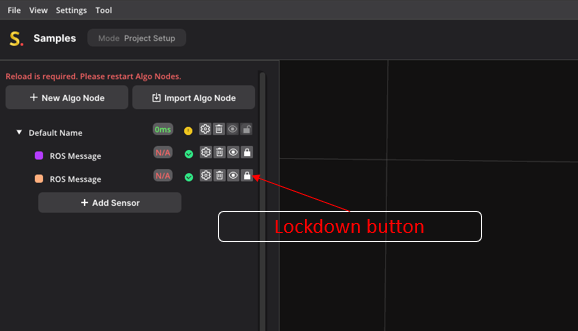
The calibration of Sensor 1 and Sensor 2 is now complete. If your installation has more sensors, you can make them visible one at a time and continue the calibration process.
You can switch back to perspective mode and look at the calibration from different angles to make sure everything looks correct.
Optimizing the World Size
This step is optional, but it is useful to understand how this works so you are able to optimize computing resources and maximize tracking performance.
One of these Algo Node Settings is the Detection Range. This is the total world size that SENSR is processing. The default for this world size is 100x100x5 meters in space. For this tutorial dataset, we are only tracking people in a single room, so the world size is much greater than the actual observable area. We can reduce processing and memory resources by reducing the world size.
On the left is the default world size of 100x100m, on the right is the optimized world size of 20x35m, an improvement of 93%
note
Note that both Algo Nodes and Sensors have Detection Ranges. A Sensor Detection Range applies to only one sensor. The Algo Node Detection Range applies to all sensors equally.
- Click an Algo Node on the list,
- Click Detection Range on the Algo Node Pose Editor and scale the Detection Range values on the workspace or at the editor.
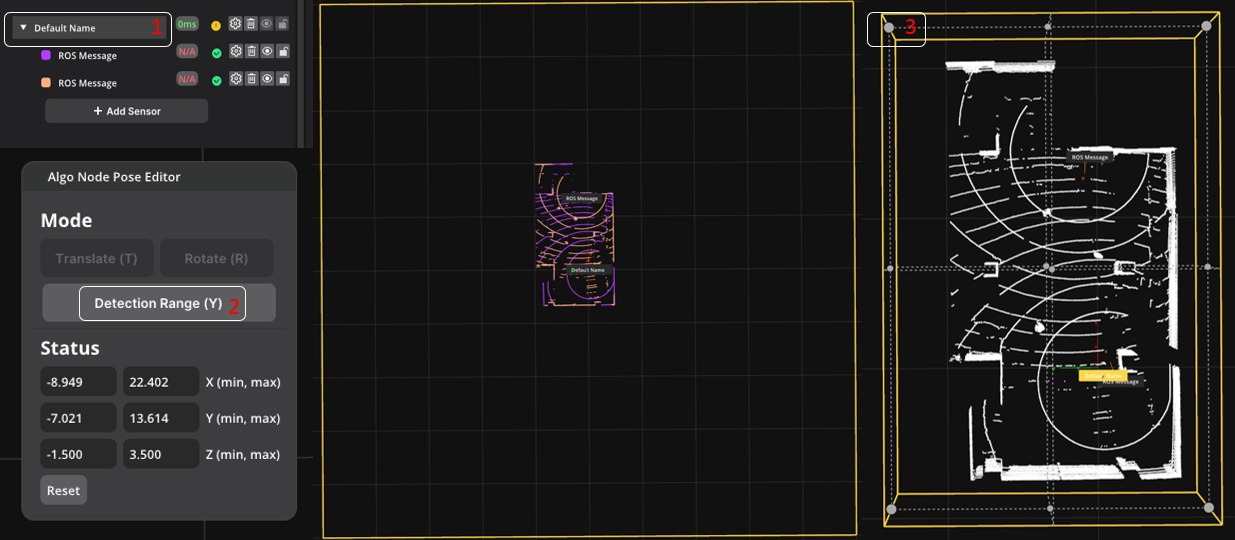
The calibration process is complete. The calibration will automatically be saved when you exit the application. Saving can also be done manually at any time during the calibration by pressing File > Save or using the CTRL+S hotkey.
You can now launch runtime to check the tracking results, or continue the manual and create zones first.
Tip: Background Map
You can import 2D or 3D maps at the background of SENSR world, like the video below.
Load a Background Map
- Open a window at
View > Background Map
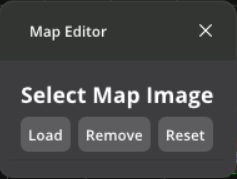
Load a background image
We support
jpegpngobjfile for the background imageCalibrate your background image with scaling, translating, and rotating
